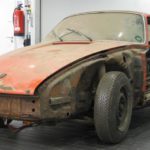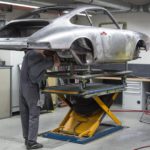After three years of restoration, the Porsche Museum will finally present one of the newest additions to its collection. And it is the oldest 911 that the museum holds. This will happen at the special exhibition “911 (901 No. 57) – A legend takes off” from December 14, 2017, to April 8, 2018. The red coupé was from October 1964 as one of the first series-production models of the sports car known back then as the 901. Almost exactly 50 years later, the Porsche Museum happened to find this rare item. The museum decided to buy it with a view to restoring it back to its original state.
Porsche originally developed and presented the successor to the 356 under the type designation 901
However, just a few weeks after starting production in the autumn of 1964, the coupé had a new name due to a trademark dispute. And from then on it bore the name 911. All of the customer vehicles produced up to that point were manufactured as 901 vehicles but sold as 911 vehicles. The Porsche factory collection had lacked one of these rarities for 50 years.
2014: TV team stumbles across a historically significant hidden treasure
In 2014, while valuing a collection of items long forgotten about in a barn, a German TV crew working on an antiques and memorabilia programme stumbled across two 911 models dating back to the 1960s. The crew made enquiries with the Porsche Museum. It emerged that one of the two sports cars with the chassis number 300.057 was one of the rare models from the period before the model line received another name. The Porsche Museum decided to buy both 911 models at the estimated price determined by an independent expert. In doing so, it closed a key gap in its collection of significant classic cars produced by the Porsche brand.
Repair before replacement: Intricate and extensive restoration using authentic parts
One of the crucial factors in favour of purchasing the vehicle was the fact that the old 911 had not been restored in any way. That gave the specialists at the museum the opportunity to restore the sports car as authentically and as true to the original as possible. It took a total of three years to bring this very rusty sports car back to its original state. The specialists used genuine body parts from the time taken from a different vehicle. The engine, transmission, electrics and interior were all repaired following the same principle. The general rule was to retain parts and fragments where possible rather than replacing them. These intricate restoration methods used by the Porsche Museum as the standard approach are precisely the reason why it took so long to bring this highly historically significant sports car back to life.
Driving at its purest- the new 911 Carrera T #Porsche #LAAutoShow #911 pic.twitter.com/Er1e53hJ0R
— Porsche (@Porsche) November 29, 2017









































